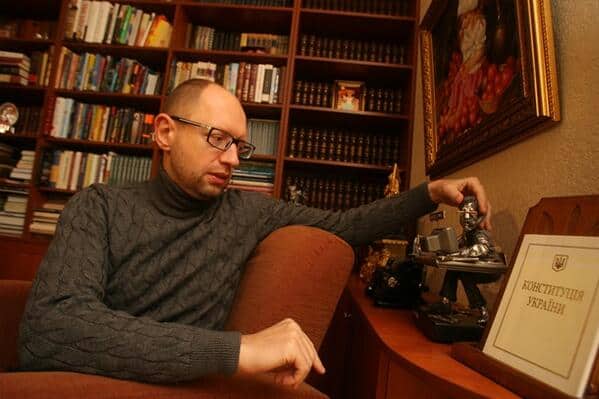In his living room, the acting prime minister of Ukraine, Arseny Yatsenyuk, has a copy of the Ukrainian constitution standing on a sideboard, clearly visible on the photograph that was taken for a PR-home story a few weeks ago when he was still a leader of the opposition. There is no way to tell which version of the main law Yatsenyuk has on display. In most post-socialist countries, new national constitutions were drafted after the Soviet Union collapsed in 1991. Many new or amended versions of the constitutional texts have been created since, usually in the framework of political transformation and crisis. This is also the case for Ukraine, which was the last post-Soviet country to adopt a new constitution in 1996.
Back to Orange
“Ukrainian politicians traditionally approached constitutional, and indeed all other issues, from the standpoint not of national interests, but personal advantage,” writes Taraz Kuzio in a 2009 article on constitutional instability and legal turmoil in Ukraine. In this article, he shows that the history of independent Ukraine has always been one of constitutional struggle where political changes went hand in hand with constitutional ones. “Ukraine will enter the January 2010 election campaign in the same state of constitutional uncertainty as it did five years ago,” Kuzio wrote. He was referring to the 2004 constitutional reform which had been one of the outcomes of the “Orange Revolution”. The new text amended the original constitutional text of 1996, giving greater powers to parliament and curbing those of the president. Kuzio’s prediction turned out to be right: In February 2010, Viktor Yanukovych won the presidential elections over Julia Timoshenko; in September 2010, the Ukrainian Constitutional Court, which had been increasingly subjected to political pressure in the years following the “Orange Revolution”, annulled the 2004 constitutional reform and reinstated the 1996 version. This constitution gave Yanukovych strong presidential powers again, such as the power to dismiss the government without parliamentary approval, to nominate candidates for the office of prime minister without parliamentary ratification, to appoint cabinet ministers, and to cancel any government resolution.
The most recent constitutional episode occurred on 21 February 2014, when the Ukrainian Parliament (Verkhovna Rada) reinstated the 2004 version of the constitution. This decision was part of a package of agreements between the acting President Yanukovych and leaders of the opposition, among them Arseny Yatsenyuk.
In summary, the country has alternated between two constitutional texts since it became independent. Each of these texts has been abolished and reinstated in the last two decades: 1996/2010 and 2004/2014.
The Crimean Constitution
The Ukrainian constitution includes a section on the Autonomous Republic of Crimea, a peninsula that had been transferred to Ukraine in 1954 by the then Soviet first secretary Khrushchev. After the ousting of Yanukovych, it is now at the heart of the crisis. Crimea enjoys the status of an Autonomous Republic with normative regulatory powers in areas as diverse as agriculture, urban construction, tourism, public transportation, roadways, or water supply. Crimea has its own parliamentary governing body which can call elections of deputies and has, among others, the authority to organize and hold local referenda, promote the protection of legal order and public security, and initiate the introduction of a state of emergency. Crimea also has its own constitution: Article 135 of the Ukrainian constitution spells out that the Crimean constitution is approved by the Verkhovna Rada of Ukraine by no less than one-half of its constitutional composition. While these arrangements sound clear-cut, the relationship between Crimea and Ukraine and their respective constitutions has been and continues to be problematic:
After declaring independence in 1991, Ukraine had provisionally adopted the last Soviet constitution of 20 April 1978 and substantially amended it. This text remained partially in force until 1996. The first Crimean constitution was already passed on 5 May 1992 – four years earlier. The very next day, however, the Ukrainian parliament pressured the Crimean parliament into adding a sentence that declared Crimea a part of Ukraine, in an effort to counter the proclamation of self-governance that Crimea had passed alongside the new constitutional text. On 17 March 1995, the first Crimean constitution was terminated by the Ukrainian parliament together with the office of the Crimean presidency as a means to curb calls for greater independence from Ukraine. By December 1998, five different versions of the Crimean constitutional text had been debated of which the final one came into effect only on 12 January 1999. The text has since then been amended several times.
In a paper on Crimean constitutionalism, Natalya Belitser comes to the conclusion that “from the very beginning, the principal aim of the entire constitutional process in Crimea was not so much to find a proper legal solution that would take into consideration all of the historic, ethnic, and cultural specifics of this region and integrate them into the general texture of Ukrainian political and economic life, but rather to appease the pro-Russian majority there, to pacify its pronounced secessionist trends, and by doing so, to avoid more violent scenarios. As a result, the Crimean peninsula has been turned into something akin to a Russian national autonomy (sic!) within Ukraine —a fact never officially recognized by the state authorities, but gradually becoming a matter of public debate.” Although her statement is already fourteen years old, her words are equally pertinent today.
Claiming Un/Constitutionality
On 23 February 2014, two days after the Ukrainian parliament reinstated the 2004 constitution, pro-Russia Crimean politicians declared events in Kiev to be “unconstitutional.” They did not specify which constitution had been violated, but there had been no (constitutional) disorder in the Autonomous Republic at this point. Nevertheless, the new local government of Crimea that had come to power on 27 February 2014 in a non-transparent emergency session, turned to Russia for help to “restore peace and calmness.”
On 4 March 2014, Russian President Vladimir Putin echoed the statement of these pro-Russia voices by declaring in a press conference on Russian live TV (see the video here and the official English transcript here) that “this was an anti-constitutional coup” – referring to the ousting of Ukrainian President Yanukovych by the Ukrainian parliament on 22 February 2014. Putin stated that “Mr Yanukovych actually handed over power. He agreed to all the opposition’s demands: he agreed to early parliamentary elections, to early presidential elections, andto return to the 2004 Constitution, as demanded by the opposition.”
Putin was referring to the agreement between the opposition leaders and Yanukovych which had been mediated by the foreign ministers of Germany, France and Poland the day before, on February 21. According to this agreement, Yanukovych would have remained president until new elections had been carried out later this year.
This leaves us with a problem: what constitutional order did Putin think was violated when he talked about an “anti-constitutional coup”? After Yanukovych signed the agreement with the opposition, he fled Kiev without signing a number of agreed resolutions. The Ukrainian parliament determined that he had in fact resigned and on February 22, the Verkhovna Rada appointed Oleksondr Turchynov as interim president, set new presidential elections for 25 May 2014 and reinstated the 2004 constitution. On 27 February, Arseny Yatsenyuk assumed the office of prime minister. The new Ukrainian government has since then declared the transition of power to be constitutional and the appointment of the new prime minister of Crimea, Sergey Aksyonov, unconstitutional. These seemingly arbitrary claims on what is constitutional and what is not have drawn commentary: Dmitry Trenin, head of the foreign-policy think tank “Carnegie Moscow Center”, is simultaneously concerned and sarcastic when warning “that Kiev might decide to intervene with force … to restore constitutional order, whatever order, revolutionary order, in Crimea”. But when does the revolutionary become constitutional? Put differently: How does one measure constitutionality if constitutions are themselves key to political transformations and are abolished or (re-)instated alongside political figureheads? Politicians from all parties within and outside Ukraine and the Autonomous Republic of Crimea have declared the actions of others to be unconstitutional. But only in rare instances are these claims specified in regard to a constitutional text. These are rather claims referring to an imagined, idealized constitution that can be invoked when needed to support one’s arguments and that can be displayed in public places or one’s living room, reminding others and oneself of righteousness and justice.
Yet Another New Constitution?
To put an end to this “chaos” as Putin put it in his March 4 press conference, he suggested the following way out: “a new constitution must be adopted, and this must be done through a referendum so that all citizens of Ukraine could feel involved in that process, the process of shaping the main principles of their state system.” This is a reasonable suggestion given how riven Ukrainian society seems today. The idea that all citizens would work together on a new main law holds prima facie promise for smoothing over differences, giving people a common goal to strive for again. At the same time, however, Putin’s suggestion is not particularly innovative. In the post-Soviet sphere, but also elsewhere, governmental takeovers and political crises are routinely answered with calls for (nation-wide) constitutional referenda. Such referenda are efforts to restore legitimacy and faith in constitutional law and the state it is supposed to govern; although it is not clear, which constitution has ever truly held off the next political crisis.
In this context, another of Putin’s statements deserves reflection: “Only constitutional means should be used in the post-Soviet space, where political structures are still very fragile, and economies are still weak. Going beyond the constitutional field would always be a cardinal mistake in such a situation,” he added. The problem is, however, that one singular reliable “constitutional field” has never existed in Ukraine to start with. Rather than the constitution serving as merely the formal legal framework for political process, politics in Ukraine and between Ukraine and Crimea has since independence been performed via constitutional change. Constitutions are key to doing politics in Ukraine – as they are in many other places.
Photo credit: News.bigmir.net









